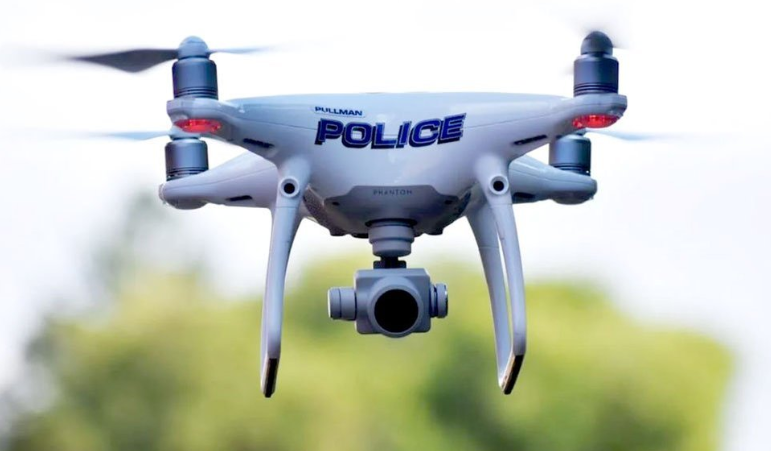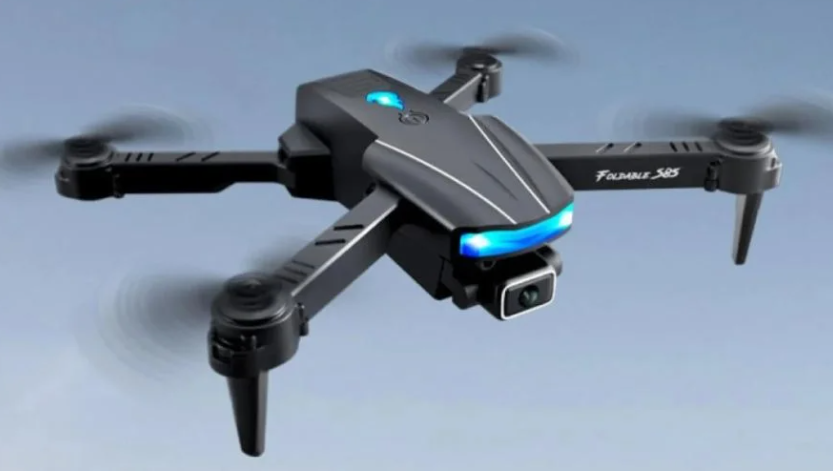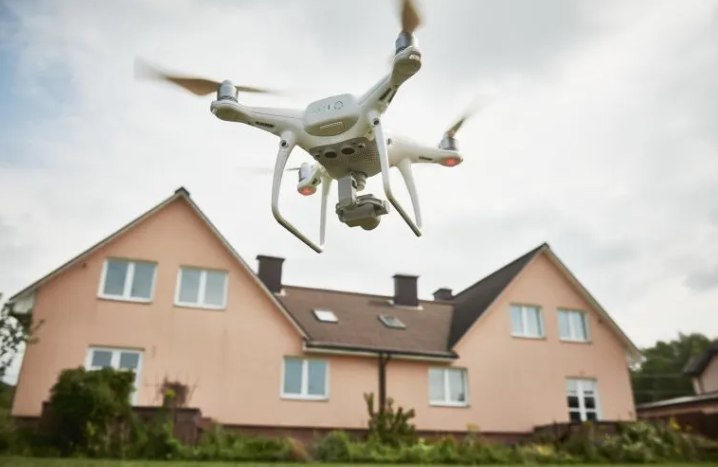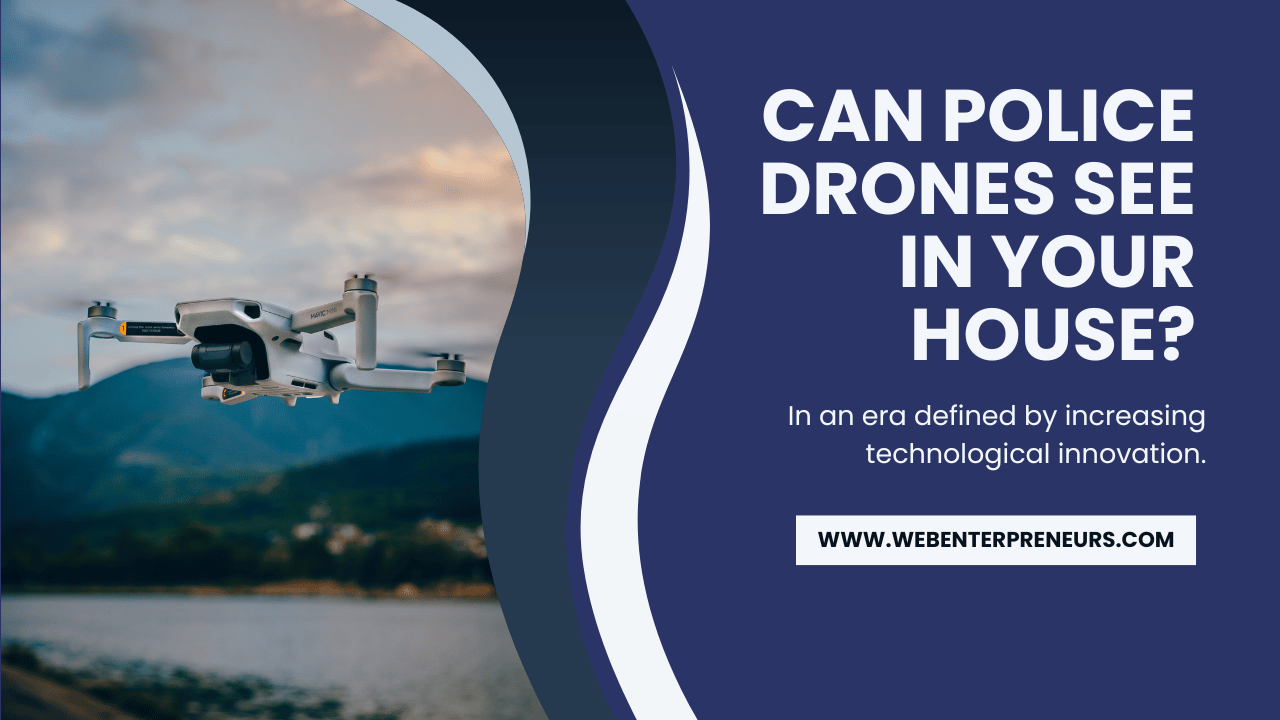Can Police Drones See in Your House? [Facts Checks for Drones]
In an era defined by increasing technological innovation, law enforcement agencies have started leveraging sophisticated tools to protect public safety. One such innovation is the use of drones, which have been increasingly adopted for their wide-ranging capabilities. While their utility in policing can’t be understated, the question often arises – can police drones see inside your house? This article will offer a comprehensive look “Can Police Drones See in Your House?”. Keep reading!
Are Police Drones Equipped with Cameras That Can See Inside Homes?

Law enforcement drones are typically fitted with high-resolution cameras that can capture crystal clear images from great heights, aiding in tasks like traffic control, search and rescue operations, and surveillance of crime-prone areas. However, the technology to see through walls or into houses using drones is currently not within the standard capabilities of these devices. Most drones can capture images through glass windows if there’s enough light, but these are typically used in extreme circumstances, such as hostage situations or for tactical support during dangerous operations.
What are the Legal Limitations on Police Drone Surveillance Inside Residential Properties?
The law plays a critical role in maintaining the balance between effective law enforcement and the protection of privacy rights. The Fourth Amendment to the U.S. Constitution, which protects citizens from unreasonable searches and seizures, is especially relevant when discussing drone surveillance and civil liberties.

In general, the law requires police to obtain a warrant before conducting any form of surveillance that infringes upon an individual’s reasonable expectation of privacy. This means that police cannot typically use drones to look inside a person’s house without obtaining a warrant first, providing a certain level of protection against unwarranted intrusions.
Can Law Enforcement Use Drones to Conduct Surveillance Inside Private Residences?
Law enforcement agencies can use drones for surveillance purposes within the limits of the law. As discussed, any surveillance that infringes upon an individual’s reasonable expectation of privacy requires a warrant. This implies that under normal circumstances, police drones cannot be used to look inside private residences without the proper legal authorization.
What Are the Privacy Concerns Surrounding Police Drones and Home Surveillance?
While the usage of police drones can enhance public safety, it is also imperative to recognize and address the privacy concerns it engenders. The idea of drones being capable of surveilling private residences can evoke a sense of unease among citizens. Privacy rights in the age of police drones have become a prominent discourse, leading to robust discussions on the need to regulate the use of these devices.
How Do Police Drones Navigate Obstacles Like Walls and Windows When Attempting to See Inside Houses?

Present-day drone technology is incredibly advanced, capable of navigating complex environments using sensors and algorithms. However, the technology to penetrate walls or opaque materials using a drone does not exist yet. Drones can capture images through transparent materials like glass if there’s sufficient light. Even then, their usage for such purposes is often strictly regulated and only employed in high-risk situations.
What are the Regulations and Guidelines for Police Drone Operations Near Residential Areas?
As drone technology evolves, so does the legislation surrounding its use. Several states have enacted laws that restrict drone usage near residential areas or require law enforcement to obtain a warrant before using drones for surveillance purposes. These laws are intended to strike a balance between enabling effective policing and protecting citizens’ privacy rights.
Can Police Drones Capture Audio Recordings Inside Homes During Surveillance?
Police drones, as of current technology, are not equipped to capture audio recordings inside homes. While they may be able to record sounds in the immediate vicinity, capturing indoor audio would likely require additional technology and legal authorization, thus placing significant constraints on this potential usage.
What are the Rights of Homeowners When It Comes to Protecting Their Privacy from Police Drones?
Every homeowner has a reasonable expectation of privacy within their own homes. This principle is protected by the Fourth Amendment, which safeguards citizens from unlawful searches and seizures. This includes unwarranted drone surveillance. If a homeowner believes that their privacy has been violated by a police drone, they should consult with a legal professional to understand their rights and potential remedies.
How do Police Agencies Balance the Need for Public Safety and Privacy Rights with the Use of Drones for Surveillance?
The crux of the debate surrounding police drones and privacy lies in striking the right balance between public safety and privacy rights. Police agencies typically use drones for legitimate law enforcement purposes, such as tracking suspects or assisting in emergencies. However, they must always be cognizant of the potential privacy implications of drone usage and act within the confines of the law to protect citizens’ rights.
The Evolution of Police Drone Technology and Privacy Implications
The increasing adoption of drone technology in law enforcement is a clear testament to the significant advancements in this field. This technology has redefined traditional methods of surveillance, search and rescue operations, traffic monitoring, and crime scene analysis. However, these advancements have sparked important debates on privacy rights in residential areas.
Technological Progression in Police Drones
The evolution of drone technology in law enforcement has been remarkable. What started as a simple tool for capturing aerial footage has now morphed into a multifaceted device with capabilities such as infrared sensors, facial recognition, and advanced navigation systems. These technologies can provide critical support during challenging operations, such as tracking a fleeing suspect at night or navigating through a dense forest during search and rescue missions.
Despite these benefits, there’s a growing concern about the potential misuse of this technology. The powerful capabilities of these devices make it possible, in theory, for law enforcement to conduct unwarranted surveillance. In response to these concerns, many states have passed laws to regulate police use of drones and protect citizens’ Fourth Amendment rights.
Fourth Amendment Rights and Police Drone Use
The Fourth Amendment of the U.S. Constitution safeguards citizens from unlawful searches and seizures, and it plays a critical role in regulating police drone operations. A key concept is the “reasonable expectation of privacy,” which asserts that law enforcement agencies must obtain a warrant to conduct surveillance in areas where an individual would reasonably expect privacy.
Given this, if a drone were to look into a person’s home without a warrant, it would likely be seen as a violation of the Fourth Amendment rights. This fundamental principle is a major determinant in shaping the regulations and guidelines around police drone operations near residential areas.
The Fine Line Between Surveillance and Invasion of Privacy
While drones provide law enforcement agencies with a powerful tool for surveillance and crime prevention, the line between surveillance and invasion of privacy can sometimes blur. In light of this, it is essential that clear regulations are established to prevent misuse.
The question isn’t just about what technology allows law enforcement to do, but what they should be allowed to do. The capability to peer into a person’s house with a drone, even if technologically possible, raises serious ethical and legal questions.
A responsible approach to police drone use should involve strict guidelines, accountability, and transparency in operations. This would not only reassure the public that their privacy rights are respected but also maintain the credibility and integrity of law enforcement agencies.
The Future of Police Drones and Home Privacy
The future of police drone use is a fascinating yet complex topic. As drone technology evolves, so too must the laws and regulations governing its use. Balancing the benefits of drones for public safety with the need to respect individual privacy rights will be a central challenge for policymakers.
Emerging technologies such as artificial intelligence (AI) and machine learning could further enhance the capabilities of police drones. These advancements might allow drones to perform complex tasks like crowd analysis, behavior prediction, or even predictive policing.
As we move forward, it’s crucial that these technologies are not used to compromise the privacy of individuals within their own homes. Protecting privacy rights in the age of police drones will continue to be a key issue in years to come.
FAQs About Can Police Drones See in Your House?
Can police drones see in my house?
As per current technology, police drones can’t see inside your house without sufficient light and transparency (like a window). Moreover, any surveillance that infringes upon an individual’s reasonable expectation of privacy typically requires a warrant.
What are my rights when it comes to police drone surveillance?
As a homeowner, you have the right to privacy within your own home. The Fourth Amendment protects you from unwarranted intrusions, including drone surveillance.
Are there laws regulating police drone use near homes?
Yes, there are. Several states have enacted laws that require law enforcement agencies to obtain a warrant before conducting drone surveillance, or that restrict drone usage near residential areas.
Do police drones have the technology to listen to conversations inside homes?
Current police drone technology does not include the ability to capture audio recordings inside homes.
Can I legally defend my property against police drones?
This is a complex legal question that depends on the specifics of the situation, local laws, and regulations. If you believe a drone is infracing on your privacy, it’s recommended to consult with a legal professional.
What kind of technology do police drones have?
Police drones are equipped with high-resolution cameras, infrared sensors, and sometimes facial recognition technology. They can capture clear images from great heights and navigate complex environments.
What’s the future of police drone use?
The future of police drones is tied to advancements in technology, particularly artificial intelligence and machine learning. These technologies could enhance the capabilities of police drones, enabling complex tasks like crowd analysis or predictive policing.
How can privacy rights be protected with the increasing use of police drones?
Privacy rights can be protected by establishing clear regulations on drone use, requiring warrants for surveillance in places where individuals have a reasonable expectation of privacy, and maintaining transparency and accountability in police drone operations.
Also Read: Virtual Reality Headsets and Frame Rate: Unlocking Immersive Experiences
Conclusion
In conclusion, while drones have become valuable tools for law enforcement, their use is not without legal and ethical constraints. The balance between security and privacy is delicate, and the debate on drone usage is bound to continue as technology continues to evolve. We hope this guide about “Can Police Drones See in Your House?” will prove much beneficial for all our readers. As responsible citizens, it’s important that we stay informed about our rights and the capabilities of these devices, fostering an environment of understanding and respect between law enforcement and the public they serve.



